While the market boasts an abundance of AI writing tools, these general-purpose solutions often fall short in the demanding world of academic writing. They lack the depth and focus required to produce high-quality research papers. This absence of specialized academic writing tools creates significant challenges for students, which extend beyond writing and impact broader academic performance. One of the primary consequences of the lack of real-time academic writing support is sub-par writing quality among students, who may also face difficulties in effectively communicating and writing in English.
This also means that students and researchers get diverted from core research endeavors and spend time improvising their drafts. Desk rejections can also lower their morale, leading to decreased productivity, writer’s block and other psychological difficulties. This vicious cycle makes it crucial to introduce the right AI writing tool to the community and create a space where academics can excel and flourish without any constraints.
Table of Contents
- Paperpal – The All-in-One AI Academic Writing Toolkit
- Why Paperpal is a Better Choice for Academics vs Other Generic AI Tools
- The Analysis: We Tested Academic Text Samples Across 4 AI Writing Tools
- The Result: Paperpal Ranks as the Best AI Writing & Editing Tool for Academics
- Demonstrating Paperpal’s Superiority in Proofreading Academic Content
- Paperpal vs Grammarly (Academic)
- Paperpal vs ProWritingAid
- Paperpal vs QuillBot
- Paperpal vs Wordtune
- Beyond Grammar: 5 Additional Features That Make Paperpal the Preferred Choice for Academics
- Paperpal: The AI Academic Writing Tool Academics Can Trust
Paperpal – The All-in-One AI Academic Writing Toolkit
Launched in September 2022, Paperpal is a comprehensive AI academic writing assistant that empowers authors to write better, faster, and more responsibly. Harnessing 23+ years of scientific, technical, and medical (STM) expertise and trained on millions of language corrections by professional academic editors at Editage, Paperpal’s AI delivers human precision at machine speed.
Why Paperpal is a Better Choice for Academics vs Other Generic AI Tools
Paperpal’s AI comprehensive writing toolkit is trusted and advocated by leading universities and top global publishers, including Wolters Kluwer, IOP, IEEE, Royal Society, and ASCO, among others.
- Trusted by 3Mn+ academics across 125+ countries
- Used to perfect 10Bn+ words
- Built on 23+ years of STM expertise
- Based on Secure LLM Technology
- NPS of 70 indicating high user satisfaction
Compared to the best AI writing tools, Paperpal is built to support students and researchers at every stage of their academic writing journey.
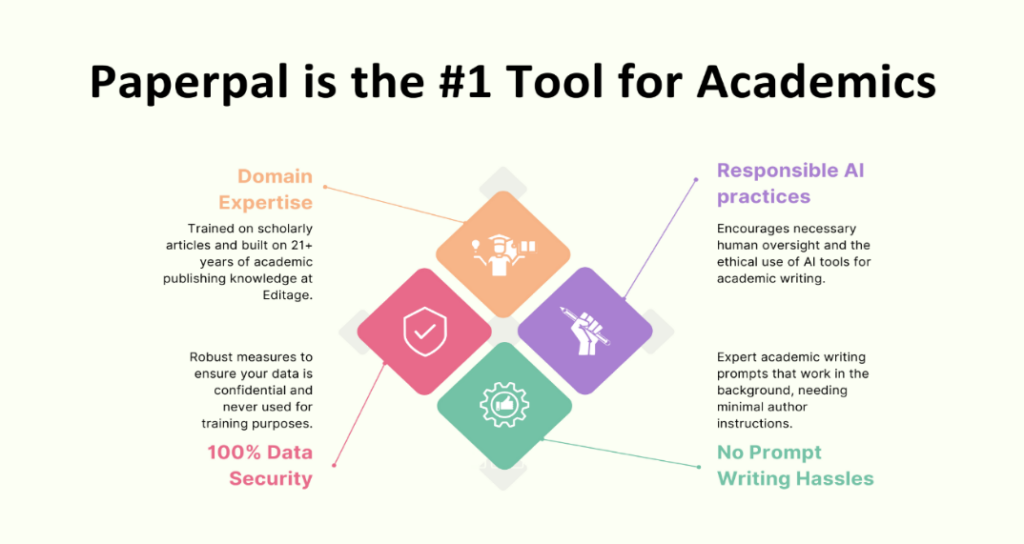
Paperpal is dedicated to ensuring the optimal experience for authors worldwide. To achieve this goal, we conducted a comprehensive analysis, comparing our platform with top AI writing tools in the industry. For anyone who has ever wondered which is the best AI writing tool to support academic writing, we have an answer now.
The Analysis: We Tested Academic Text Samples Across 4 AI Writing Tools
Senior editors from the Editage training department conducted a blinded benchmarking analysis of four AI writing tools for academic writing – Paperpal, Grammarly (Academic mode), QuillBot, ProWritingAid, and Wordtune – to understand their performance when enhancing academic content.
Each of the tools were tested on samples comprising snippets of text taken from 7 different research articles across 6 domains – Biochemistry, Medicine, Material Science, Engineering, Sociology, and Business. The editors then tagged the results into 4 broad types of language errors (see key below). The experts determined the accuracy of each tool based on the number of suggestions that seemed to be valid and the extent of corrections missed when compared to editing done by human experts.
| Grading Category | Error types |
| Thoroughness | Proofreading, Consistency, Punctuation |
| Language | Grammar, Readability |
| Comprehension | Clarity, Contextual understanding, Subject matter expertise |
| Integrity | Flow of information, Document structure and integrity |
The Result: Paperpal Ranks as the Best AI Writing & Editing Tool for Academics
Based on the benchmarking analysis, Paperpal stood out as the best academic writing and English editing tool for students and researchers, in terms of editing coverage, accuracy, and effectiveness.
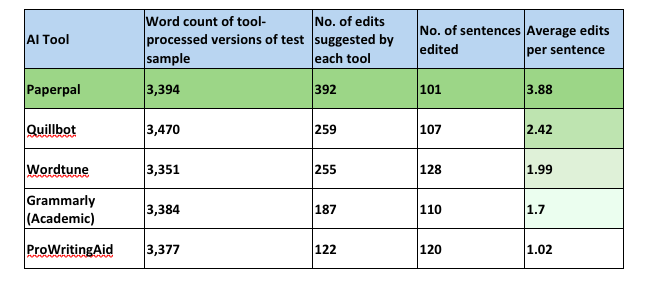
As seen in the table above, in terms of coverage Paperpal provides the highest number of suggested edits (392) with 3.88 edits per sentence on average, which is >2x the number of edits that Grammarly (Academic mode) does. This is significant as tools that provide minimal coverage can only be relied on for basic checks instead of being reliable solutions to increase the overall quality, readability, and flow of academic text.
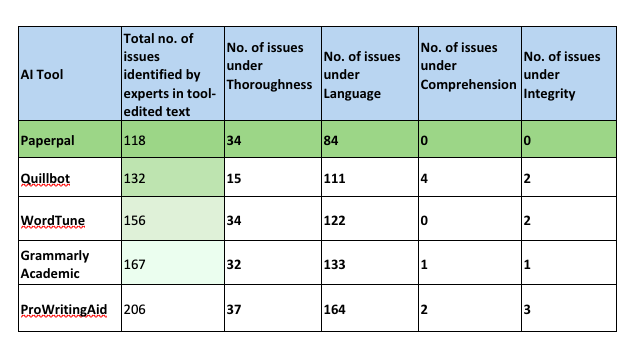
In the table above, we see that experts also identified the least number of issues in Paperpal-edited documents (118), with lowest issues in Language, and no issues seen under Comprehension and Integrity grading categories. On the other hand, ProWritingAid and then Grammarly (Academic mode) had the highest number of incorrect suggestions across categories. A large volume of irrelevant or incorrect edits means that most of the author’s time is spent rejecting suggestions, which makes it unlikely the AI tool will be considered helpful.
Demonstrating Paperpal’s Superiority in Proofreading Academic Content
The Editage team of experts delved deeper to qualitatively understand where these individual AI tools fell short in evaluating and enhancing the academic text samples. In the following few pages, we share some examples that clearly illustrate how the different AI tools handled complex academic writing.
They found that Paperpal, with specialized training data comprising millions of published research articles, domain understanding built on 20+ years of professional academic editing, and secure AI checks set on a secure platform, was the preferred academic writing and English editing tool.
In each of the comparisons below, you can see how Paperpal has the most comprehensive and precise recommendations, making it the best AI writing assistant for academics across the world.
Paperpal vs Grammarly (Academic)
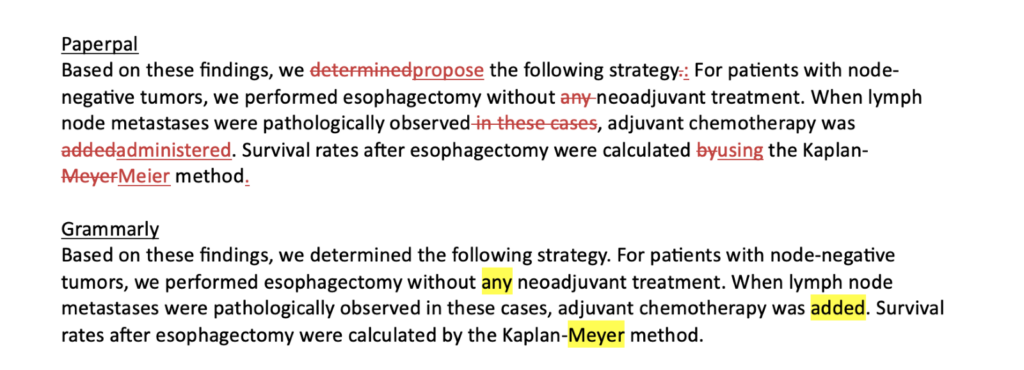
With the lowest number of tool-proposed edits after ProWritingAid, Grammarly’s error detection is decidedly poor in comparison to Paperpal, even in its Academic mode. It fails to correct specific word choice (“administered” works better with chemotherapy, not “added”) and does not understand technical terminology (“Kaplan-Meyer” should be “Kaplan-Meier”).
Compared to Grammarly, Paperpal corrected: Word choice, punctuation, technical terminology, and overall quality.
Paperpal vs ProWritingAid
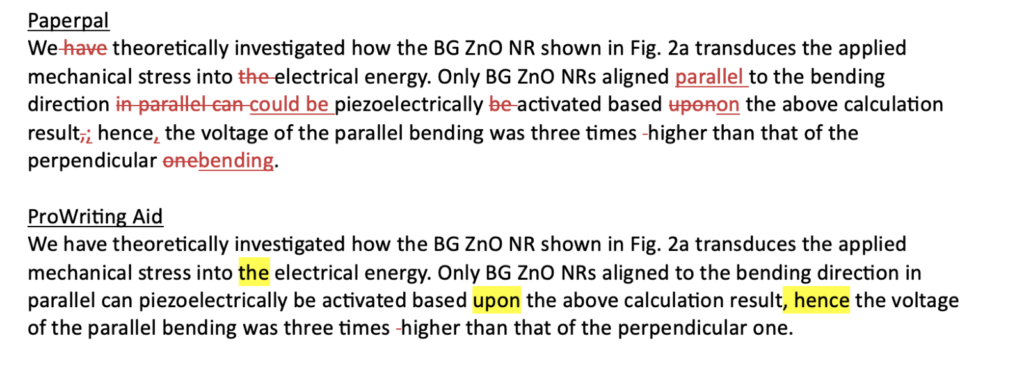
ProWritingAid offers the least suggestions among the five AI tools, which is visible here as well. Unlike Paperpal, large sections of text are left uncorrected by ProWritingAid. Even major grammar issues (unnecessary article usage before “electrical energy”) and punctuation errors (around “hence”) are missed, resulting in clumsy sentences that affect readability and flow.
Compared to ProWritingAid, Paperpal improved grammar, punctuation, readability, and flow.
Paperpal vs QuillBot

When looking at the samples above, we see QuillBot provides heavier suggestions than Paperpal. However, many of these involve an unnecessary rephrasing of the original text. With paraphrasing at its core, QuillBot often tends to “dumb down” academic text into more generalized basic language. Not only do these types of heavy revisions deviate from the author’s own voice and tone, but they also tend to change the meaning (“external fluctuation” is valid terminology in this context; revising it to “even when things change outside” results in a different meaning).
Compared to QuillBot, Paperpal improved clarity, sentence structure, and maintained academic tone while retaining the author’s voice and meaning.
Paperpal vs Wordtune
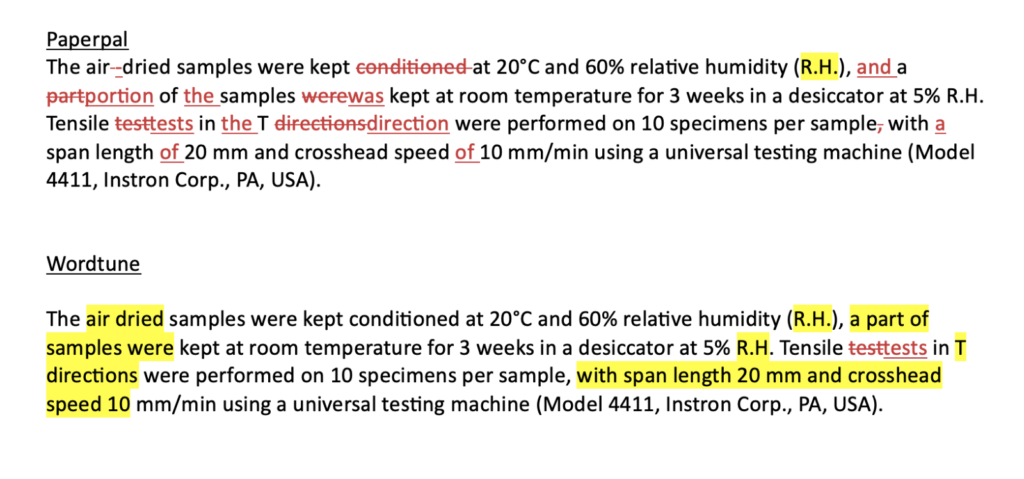
On technical portions, Wordtune tends to be highly conservative with suggestions as compared to Paperpal. In the example above, we can see that it misses corrections to basic grammar issues like hyphenation (“air-dried), subject-verb agreement (“part of the samples were”), and article usage (“a” before “span length”), which makes it unsuitable for the precise language needed in academic writing.
Compared to Wordtune, Paperpal improved language quality, grammar, accuracy, and readability.
Beyond Grammar: 5 Additional Features That Make Paperpal the Preferred Choice for Academics
Inclusive writing practices for academic content
Paperpal is trained to ensure more inclusive writing, such as using person-first language that is a critical requirement when writing in the fields of medicine and healthcare. In the example below, Paperpal edits “SARS and MERS patients” to “patients with SARS and MERS” separating the person from the diagnosed disease or disability; this nuanced correction makes it a better alternative for Grammarly.

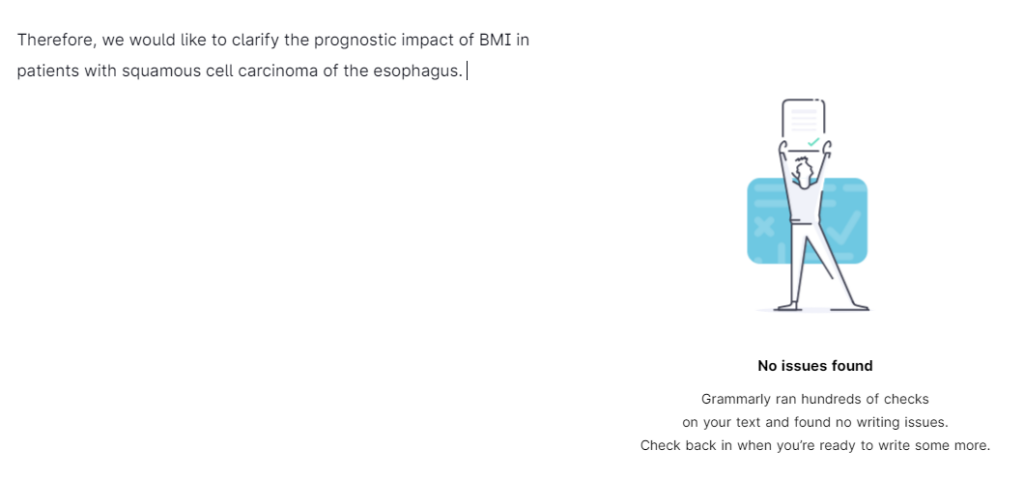
Paperpal (above) edits ensure inclusive text, but Grammarly (below) fails to identify the issue.
Real-time AI translation to overcome language barriers
Unlike any of the other tools, Paperpal supports academics with English as a second language, allowing them to translate across 50+ languages as they write. Those struggling to convey their ideas in English can simply type in the language they are most comfortable with and highlight it. Paperpal will instantly detect that the text is not in English and offers an accurate English translation that can be copied and used as needed.

Paraphrasing that accurately retains statistics and equations
Paperpal’s paraphraser has been trained to accurately handle technical academic writing. This ensures it rewrites text accurately while ensuring any statistics, equations, or units of measurement present in the academic content are retained correctly. In the examples below, QuillBot introduces errors while rewriting text, while Paperpal identifies and retains key elements, making it a better paraphrasing solution for academics.


Paperpal (above) presents the p-value accurately, while QuillBot (below) modifies it incorrectly.


Paperpal (above) accurately retains original equation, while QuillBot (below) rewrites it incorrectly.
Automated consistency checks for cohesive writing
Paperpal helps eliminate spelling, presentation, and style errors with a consistency check specifically built to detect inconsistencies in academic writing. This automated feature checks for consistency in word forms and spelling; numbers and statistics; and presentation in tables, figures, and equation labels, saving time authors would otherwise spend on manual checks. Moreover, by improving overall quality and readability, it allows professors, journal editors, peer reviewers, and readers to navigate through your writing smoothly and focus on the content without cosmetic distractions.

Choice of editing modes based on author needs
Paperpal also allows academics to choose between its Essential and Extensive 2.0 editing modes based on their needs at different stages of the writing process. This allows Paperpal to cater to both beginners, who need more in-depth language refinements, as well as experienced writers only looking for the fundamental grammar checks.

Paperpal: The AI Academic Writing Tool Academics Can Trust
See what academics who’ve rated Paperpal as excellent with 4.6 on Trustpilot have to say!

Paperpal is a comprehensive AI writing toolkit that helps students and researchers achieve 2x the writing in half the time. It leverages 23+ years of STM experience and insights from millions of research articles to provide in-depth academic writing, language editing, and submission readiness support to help you write better, faster.
Get accurate academic translations, rewriting support, grammar checks, vocabulary suggestions, and generative AI assistance that delivers human precision at machine speed. Try for free or upgrade to Paperpal Prime to access premium features, including consistency, plagiarism, and 30+ submission readiness checks to help you succeed. Experience the future of academic writing – Sign up to Paperpal and start writing for free!



